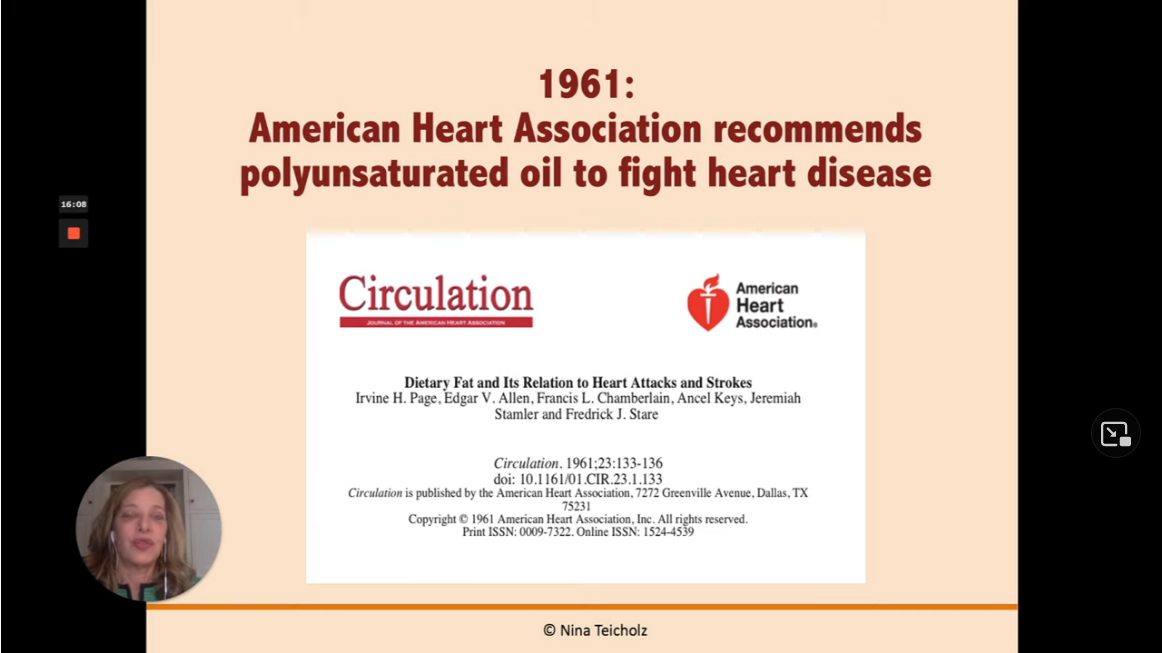A short history of seed oils as food, according to Nina Teicholz, and the Future of Fat Summit (March 2022).
This is part one in a series of short posts sharing nutrition information from the Future of Fat Summit, which is being sponsored by Zero Acre Farms. Zero Acre intends to announce an alternative to seed oils in the near future with help from investors. This information is not an endorsement of Zero Farms, or any seed oil alternative. However, the Future of Fat Summit does offer a digestible (ha!) format, presenting some of the crucial problems with the seed oil industry, and we might as well dig in especially if you’re wanting to avoid pain and inflammation.
A super-condensed history of seed oils from the Future of Fat Conference
These are the crimp notes of the abbreviated notes from journalist and food science writer Nina Teicholz, author of “The Big Fat Surprise.”
Nina says she receives no monetary compensation from competitors to the seed oil industry, so hopefully that makes her history more accurate than not.
Here are Nina’s big takeaways from the history of seed oils:
There was no polyunsaturated cooking fats
In the early 1900s, there was no such thing as a consumable seed oil or polyunsaturated oil that would be used for cooking (even olive oil didn’t have much a role in this she says).
Existing seed oils, like cotton seed oil, was used for lubricating machinery, and they were liquid at room temperature.
All cooking was done in animal derived fats, like butter, lard, suet, and tallow that started as solids at room temperature.
Proctor and Gamble (P&G) were first to market with a consumable seed oil that was solid at room temperature (a factor was stopping the public from giving up their traditional fats).
Hydrogenation leads to shelf stable seed oils that can compete with traditional fats
P&G scientists added hydrogens (hydrogenation) to long-single chain fatty acids of cotton seed oil in a process that created a gray clumpy solid that was then cleaned and deodorized and called Crisco/Shortening around 1911.
They were originally trying to refine their ability to make soap, and made Crisco.
Hydrogenation did more than just make seed oils solids at room temperature; other seed oils would go rancid quickly, but now these oils could be partially hydrogenated and become shelf-stable for a very long time which means they were a prime ingredient for the birth of boxed food products.
This process led to the creation of margarine.
Heart disease was a marketing opportunity for seed oil to become a health food
Crisco and seed oils as health-food product only took off in the early 1960s, when in 1961 and American Medical Association threw support behind the idea that polyunsaturated fats were better for you than saturated fats from animal sources, especially when it came heart disease.
Heart Disease came to the forefront of the public mind with the congestive heart failure of the American President Franklin Delano Roosevelt.
The AMA and eventually the full weight of the Federal government’s many agencies were thrown behind the Ancel Key’s theory that high dietary cholesterol could lead to heart disease (over and above other factors) and “vegetable” oils were born as a health food.
These changes were made without yet having long term clinical trials showing a strong association between a diet with saturated fats and heart disease.*
Center for Science in the Public Interest supported the notion that vegetable oils were a heart-healthy alternative to animal derived fats.
Trans-fats prove seed oils aren’t pure, and the seed oil wars begin
A little bit of confusion come into the industry when it was discovered that hydrogenation created trans-fats (perhaps more dangerous than dreaded animal fats), and partially hydrogenated oils became more common.
In the last several decades we’ve seen the rise of the seed oil wars, as soybean oil industry, attacked the palm and palm kernel oil industry, and everyone attacked coconut oil, and now alternative to polyunsaturated fats are now on the market, like avocado oil.
People are now looking for alternatives to traditional seed oils, but maybe people are not going back to great-great-grandmas lard, especially when eating meat and animal products may be considered unfashionable.
*The association between non-high density lipoprotein density in the blood stream and cardiac events is a slightly different concept than trying to draw a firm connection between saturated fat in the diet and heart disease, but this distinction is hard to follow for most people.
- Announcing the Winter Boot Drive of 2024 (to benefit homeless) - December 16, 2023
- Thoughts determine the quality of life – Tips for new patients (Part 8) - September 18, 2023
- Why hasn’t anyone told this to me before? Tips for new patients (Part 7) - September 18, 2023


